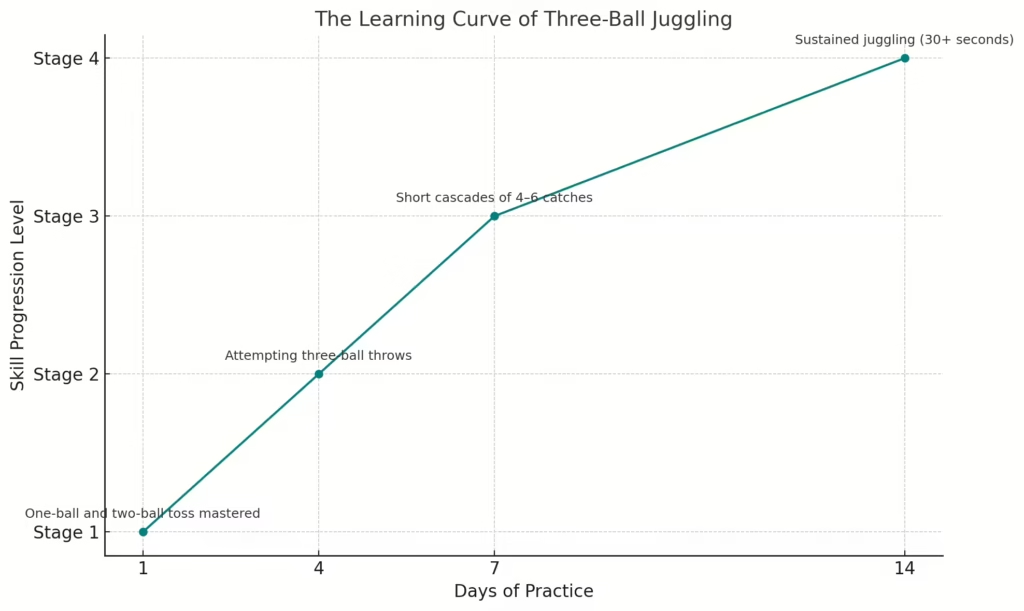A Deep Dive into Skill, Focus, and Brain Power
Juggling has captivated people for thousands of years — from ancient Egyptian murals to street performers and neuroscientists. What seems like a fun trick is actually a powerful fusion of physics, psychology, and physiology.
In this blog, we’ll unpack everything about three-ball juggling:
- The origins and history
- The science behind the skill
- A step-by-step guide
- The cognitive and physical benefits
- And why it’s a perfect metaphor for learning and life.
A Brief History of Juggling
Juggling dates back at least 4,000 years.
- Ancient Egypt: Tomb art depicts women tossing objects in arc-like patterns.
- China & India: Early acrobatics incorporated balancing and juggling.
- Medieval Europe: Jugglers, or “gleemen,” were traveling entertainers.
- Modern circus era: Brought structured props and timing to a mass audience.
Today, juggling is not just entertainment — it’s used in education, therapy, neuroscience, and mindfulness training.
Why Juggling Is More Than a Trick — It’s Brain Training
Three-ball juggling might look like a motor skill, but it also develops perception, anticipation, focus, and rhythm.
What Happens in Your Brain
- Neuroplasticity: Studies (e.g., Draganski et al., 2004) show juggling increases gray matter in motion-sensitive areas of the brain.
- Bilateral Coordination: Both hemispheres must communicate fluidly to coordinate hands.
- Error Detection and Correction: Every catch and drop sharpens real-time feedback loops.
“Learning to juggle is like giving your brain a full-body workout.”
The Mechanics of the Cascade Pattern
The cascade is the fundamental pattern of three-ball juggling.
Key Concepts
- Arc-based Throws: Each ball follows a mirrored arc from one hand to the other.
- Timing: Throw the next ball when the current one reaches its peak.
- Rhythm: The secret is consistent timing — not speed.
Pattern Diagram:
Ball A → (peak) → caught by Left
Ball B → (peak) → caught by Right
Ball C → (peak) → caught by Left
(repeat)
This sequence forms a loop — the basis for thousands of variations.
Step-by-Step: Learning to Juggle 3 Balls
🔹 Step 1: One Ball Practice
- Toss the ball from hand to hand in a gentle arc.
- The peak should be around eye level.
- Focus on consistency and catching with relaxed hands.
🔹 Step 2: Two Ball Timing
- Start with one ball in each hand.
- Toss the first ball, wait for its peak, then toss the second.
- Practice the throw-throw-catch-catch rhythm.
- Avoid throwing both at once — this builds timing and anticipation.
🔹 Step 3: Add the Third Ball
- Start with two balls in your dominant hand.
- Throw Ball 1 → Ball 2 at the peak of 1 → Ball 3 at the peak of 2.
- Catch and stop after a few throws. Then extend the pattern gradually.
Tip: Use beanbags at first — they won’t roll away when dropped.
The Learning Curve: Patience Is the Path
Many beginners struggle at first, but juggling follows a steep but predictable curve:
| Days Practiced | Expected Progress |
|---|---|
| 1–3 | One-ball and two-ball toss mastered |
| 4–7 | Attempting three-ball throws |
| 7–14 | Short cascades of 4–6 catches |
| 14+ | Sustained juggling (30+ seconds) |

Keep a journal or film your practice — it’s rewarding to see your own progress.
Mental & Physical Benefits of Juggling
Cognitive
- Enhances neuroplasticity and motor learning
- Improves attention span and focus
- Trains working memory and sequencing
- Sharpens multitasking and reaction time
Physical
- Boosts hand-eye coordination
- Improves ambidexterity
- Strengthens shoulder and upper body stability
- Improves posture and proprioception
Emotional & Psychological
- Induces flow state and mindfulness
- Reduces stress and anxiety
- Builds patience, resilience, and emotional regulation
Juggling and the Brain: What Science Says
Study Highlights
- Draganski et al. (2004) — MRI scans showed gray matter increases in adult learners after just 3 months of juggling.
- Oxford University (2011) — Juggling boosts structural brain changes even when the skill deteriorates from lack of practice.
- Neuroimage (2016) — Functional connectivity in the visual-motor network improved with juggling training.
Advanced Practice: Beyond the Cascade
Once you master the three-ball cascade, explore:
- Reverse cascade
- Mills Mess
- Shower pattern
- Columns
- Passing (with partners)
Each pattern enhances different timing and spatial skills — making juggling endlessly engaging.
Final Thoughts
Three-ball juggling is a microcosm of learning:
- You fail often
- You build rhythm
- You integrate feedback
- And then suddenly — it clicks.
Whether you’re looking for brain training, a calming ritual, or just a cool skill, juggling offers it all. It connects body, mind, and motion in a beautiful loop of intentional movement.
So next time you’re looking for a break, pick up three balls — and give your brain a workout.
Leave a Reply